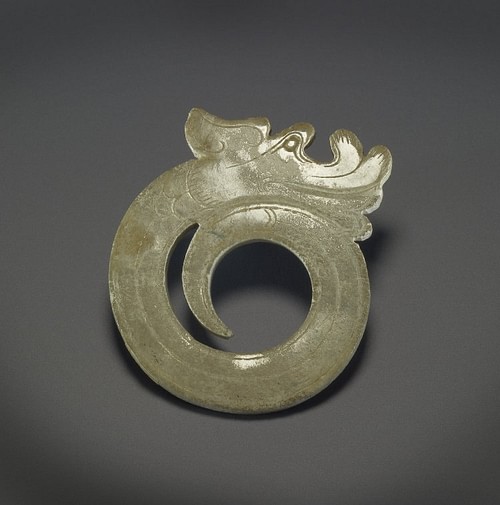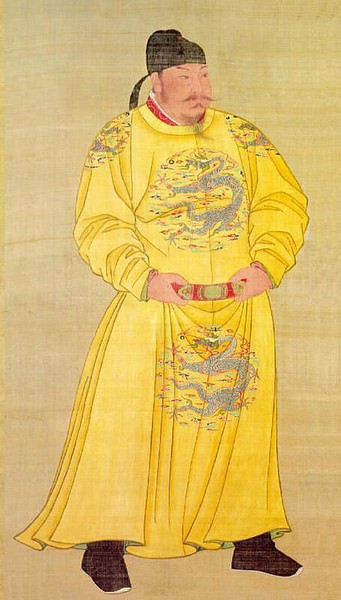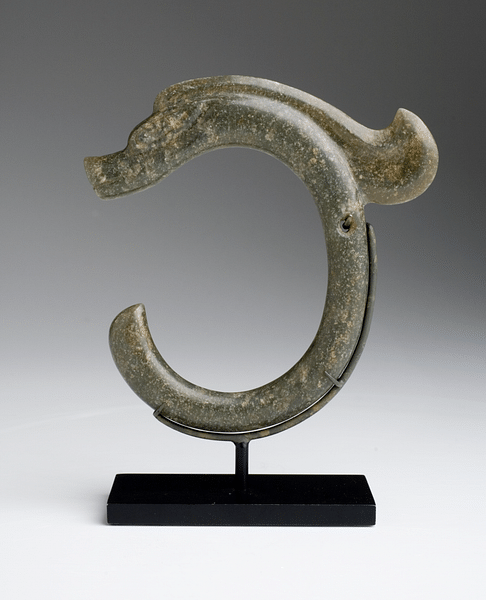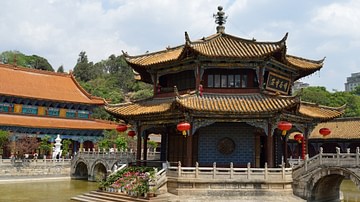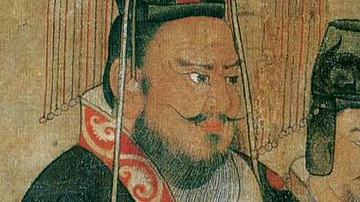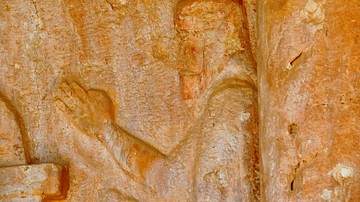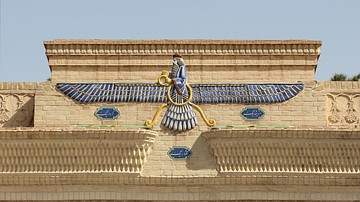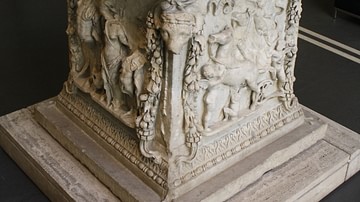Dragons appear in the mythology of many ancient cultures but nowhere else in the world was the creature quite so revered as in China. There, in marked contrast to other world mythologies, the dragon was almost always seen in a positive light and particularly associated with life-giving rains and water sources. Considered the most auspicious year sign, worn on the robes of emperors, depicted in the most precious materials from gold jewellery to jade figurines, and with countless references in literature and the performing arts, the dragon was everywhere in ancient China and looms as large today in the Chinese psyche as ever.
Origins & Physical Attributes
One of the earliest creatures to appear in the tales and legends of ancient China, the dragon is most often depicted as a giant and lithe beast which dwells in either water sources or clouds. The Chinese dragon is extraordinarily powerful, and when it flies, it is usually accompanied by lightning and thunder. When, by whom, and on what reality the dragon was first invented is not known, although some historians suggest a link with rainbows and a 'serpent of the sky' which is seen after rain showers or at waterfalls. Carved jade dragons have been excavated at sites of the Hongshan culture, which can be dated to 4500-3000 BCE, far before any written records of the creature appeared. The historian R. Dawson gives the following description of the Chinese dragon's physical attributes:
As chief among the animals the dragon was supposed to be composed of outstanding features of other animals. The traditional description gives it the horns of a stag, the forehead of a camel, the eyes of a demon, the neck of a snake, the belly of a sea-monster, the scales of a carp, the claws of an eagle, the pads of a tiger, and the ears of an ox. (231)
Alternative descriptions give similar attributes but sometimes with the body of a snake, the eyes of a rabbit, the belly of a frog, and the antlers of a deer. Other qualities of the dragon were that it could change its shape and size at will and disappear or reappear wherever it wished.
The Chinese scholar Wen Yiduo suggested that this fantastic collection of beastly parts was actually based on the political union of several different tribes, each with a different animal as their totem. The dragon was, therefore, a symbolic representation of the assimilation of these tribes into a single nation. An interesting hypothesis, it does not, however, explain the appearance of dragons long before any such political associations existed in early Chinese communities.
Powers & Associations
Despite the dragon's fearsome aspect, it was not usually seen as the bad-intentioned monster that inhabits the myths of other cultures around the world where it is typically slain by a brave hero figure. Indeed, in China, the dragon was and is regarded as being a just and benevolent creature. It is for this reason they became associated with rulership and especially the emperors of China who, in their capacity as the holders of the Mandate of Heaven and as God's representative on earth, must always rule in a just and impartial manner for the good of all their subjects.
Another reason rulers should emulate dragons is that the creature was considered one of the four most intelligent animals (along with the phoenix, unicorn, and tortoise). One famous myth tells of a dragon actively helping a ruler, Yu the Great (c. 2070 BCE), the legendary founder of the Xia dynasty, who was helped by a dragon (or actually was a dragon) and a turtle to manage the floodwaters which were devastating his kingdom and so control them into a better irrigation system.
The populace, in general, considered the dragon as a lucky symbol and bringer of wealth. Further, ancient farmers thought dragons brought much-needed rains and water to aid their crops. Dragons were also thought responsible for strong winds, hailstorms, thunder, lightning, and tornadoes - the latter are still known today as 'dragon's whirlwind' or long juan feng. It is also interesting to note that many early depictions of dragons in jade are circular.
In rural communities, there was a dragon dance to induce the creature's generosity in dispensing rain and a procession where a large figure of a dragon made from paper or cloth spread over a wooden frame was carried. Alternatively, small dragons were made of pottery or banners were carried with a depiction of a dragon and written prayers asking for rain. Attendants would follow the procession carrying buckets of water and, using willow branches, they would splash onlookers and cry “Here comes the rain!”. When it seemed that a drought was imminent, another appeal for rain was to draw pictures of dragons which were hung outside the home.
The dancing processions had another handy purpose too, which was to ward off illnesses and disease, especially in times of epidemics. The dragon dance became a part of rural festivals and came to be closely associated with the Chinese New Year celebrations. The link between dragons and rain, dancing and healing may all derive from shamanism, commonly practised in ancient China.
In folk-tales, there was a race of dragons led by their Dragon-king Lung-Wang. With scaly bodies, four legs, and horns they could take on human form and whisk away young girls. They are similar to Nagas, the snake-like creatures of Hindu folklore which protect water sources. In Chinese art, these dragons often possess a magnificent pearl whose iridescent sheen is reminiscent of a rainbow and which may represent the idea of treasure connected with that phenomenon.
Another traditional belief was that the Four Seas of the world (to the ancient Chinese there were four and not seven) were each presided over by a dragon king. Their names are Ao Kuang (who rules the East), Ao K'in (South), Ao Jun (West), and Ao Shun (North). Ao Kuang is the leader, but all four must bow to the will of the Jade Emperor whom they offer homage to in the third month of the year, the month of the heaviest rains. Besides these more lordly figures, locals often believed that any nearby water source was the home of a dragon. The long-standing connection between dragons and rivers is attested by the fact that over 40 Chinese rivers have the word dragon in their name.
The dragon came to have a certain significance in some of the more formal Chinese religions, too. In the paintings of Chan Buddhism, a dragon appearing from behind clouds was a symbol of truth and the difficulties in seeing it clearly. For Taoists, the dragon was even more important and represented the central omnipresent force known as the 'Central Way' or Tao. The four dragon kings of the Four Seas were also adopted by Taoists. Finally, the dragon is the fifth sign of the Chinese zodiac or shengxiao and associated with one of the 12 years in the calendar cycle, the most recent 'year of the dragon' being January 2012 to February 2013.
Dragon Robes
As we have seen, the dragon and Chinese emperor were a perfect match - the supreme creature from mythology and the most important person in the realm, the Son of Heaven, no less. Indeed, for many, the emperor was actually an incarnation of the supreme rain-bringing dragon. The emperor, then, in order to emphasise this auspicious association, wore silk robes with dragon motifs exquisitely embroidered on them, sat on a throne with carved dragons, and had his palace adorned with architectural decorations showing dragons. The dragon associated with the emperor always had five claws to distinguish it from other lesser dragons who only had four claws.
The so-called Dragon Robes of the emperor, or longpao, varied depending on the dynasty. Qin emperors had one of the most impressive get-ups with a full-length surcoat which fastened at the side and was emblazoned with nine five-clawed dragons floating over clouds, rocks, and sea, which symbolised the three elements of the universe. Emperors' wives and certain privileged and high-ranking officials of the court and their own wives could also wear dragons, but the size, colours, and cut of these robes were all strictly controlled in an intricate hierarchy of social convention. Occasionally, dignitaries and ambassadors from foreign states were permitted the honour of wearing dragon robes while on their official visit to court.
Dragons in Chinese Art
As mentioned above, dragons were a popular theme in some religious paintings, but they were too striking an image for more secular artists to resist. Dragons appeared in jewellery pieces, were carved in jade, painted on fine porcelain, carved and inlaid in lacquerware, carved in stone to decorate gardens, engraved on weapons and armour, and depicted in paintings and wall hangings. Dragons were used in decorative borders on ceramics and bronzes, and these became increasingly stylised so as to no longer be recognisable as the creature which originally inspired them.
The earliest known depiction of a dragon is a stylised C-shaped representation carved in jade. Found in eastern Inner Mongolia, it belonged to the Hongshan culture, which thrived between 4500 and 3000 BCE. Just as the dragon continues to be a popular subject in Chinese art, the Hongshan figure, although the first, is still probably the most well-known as it is used today in everything from company logos to posters welcoming visitors at Beijing's international airport.
The Dragon Boat Festival
The Longzhou jie or Dragon Boat Festival was originally held in honour of the poet and statesman Qu Yuan (c. 340-278 BCE). The Chu Minister of State had ended his life by jumping into the Miluo River, which was his dramatic response to being exiled following a slanderous assault on his character by a rival politician. Boats were launched to search for his body but to no avail, and so his supporters threw into the waters rice dumplings (zongzi) in his memory. To further commemorate the tragedy, a boat race was held on the river each year thereafter – a practice which then spread to other rivers across China and which soon took on the wider function of placating the rain-bringing dragon. Consequently, the boats typically have a dragon head on their prow and a tall dragon's tail at the stern. The race is today a colourful part of the Duanwu Festival and is usually held on the fifth day of the fifth lunar month.

